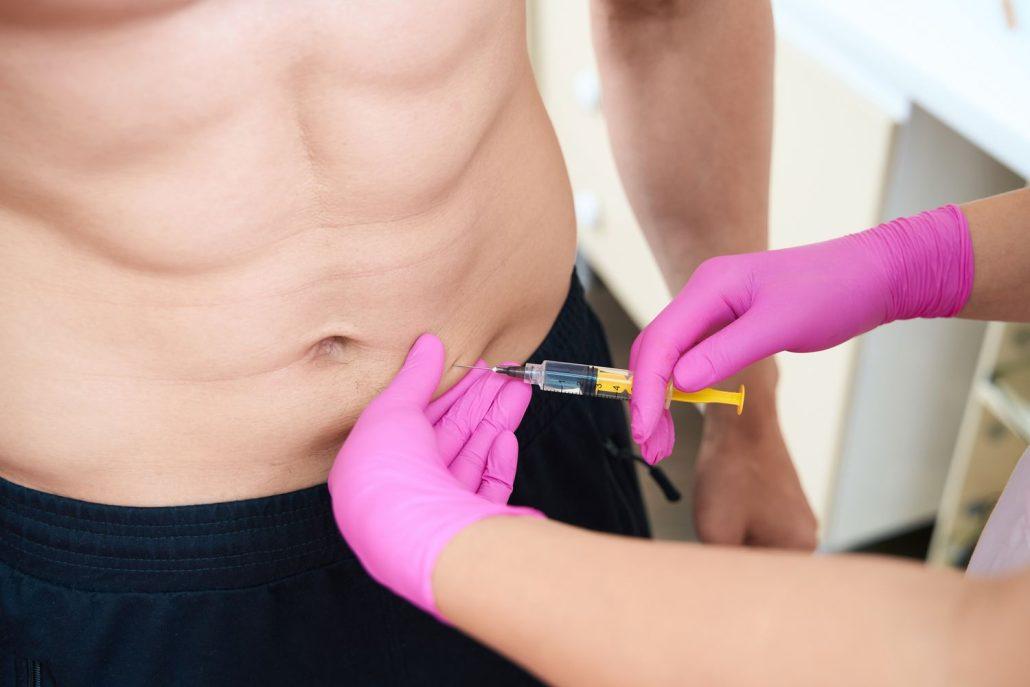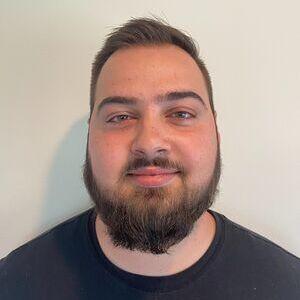- Nicholas DiBella
- Published: January 1, 2025
- Fact-checked by Dr. Desiree Granados

Building muscle can be challenging, especially if you’re dealing with low testosterone levels. Testosterone replacement therapy (TRT) offers a solution for individuals struggling to gain strength and size due to hormonal imbalances.
In this blog, we’ll explore how testosterone impacts muscle growth, provide a step-by-step guide to maximize muscle-building efforts with TRT, and answer common questions about the process. Whether you’re new to TRT or looking to enhance your results, this guide will help you navigate the journey to a stronger, healthier body.
Testosterone and Muscle
For individuals with low testosterone levels, gaining muscle can be a significant challenge. Symptoms of low T, such as decreased energy and reduced strength, can hinder efforts in the gym. At The Sanctuary, we often recommend testosterone replacement therapy (TRT) as a solution for these issues.
Testosterone plays a vital role in muscle growth by promoting protein synthesis, which is essential for building and repairing muscle fibers. It also increases the availability of growth factors that aid in muscle development and enhances the body’s ability to recover after workouts.
By restoring testosterone to optimal levels, TRT can provide the hormonal support necessary for muscle growth and improved physical performance.
Step-by-Step Guide for Building Muscle with Testosterone
1. Consult a Healthcare Provider to Start TRT
Begin by consulting with a qualified healthcare provider to determine if TRT is right for you. Your doctor will assess your testosterone levels through blood tests, review your symptoms, and discuss potential benefits and risks.
If your provider deems that TRT is appropriate, they will prescribe the correct dosage and form, such as injections, gels, or patches, etc. and explain how to use them properly. It’s important to follow their instructions closely to ensure safety and effectiveness.
2. Develop a Personalized Strength Training Routine
Building muscle requires consistent and targeted strength training. Start by setting clear fitness goals and assessing your current fitness level.
A personal trainer can help you set goals, design a customized fitness program, and ensure you’re using proper form so you prevent injury.
For building muscle, our personal trainers usually recommend a program that focuses on compound exercises like squats, deadlifts, bench presses, and pull-ups, which work multiple muscle groups simultaneously for maximum efficiency.
We also recommend “progressive overload,” which means gradually increasing the weight or resistance to challenge your muscles. Finally, you’ll want to incorporate accessory exercises that address specific muscle imbalances.
3. Optimize Your Nutrition
Muscle growth relies heavily on a diet tailored to support your fitness goals.
Prioritize lean proteins such as:
- Chicken
- Fish
- Eggs
- Plant-based options to provide the amino acids necessary for muscle repair and growth
Include healthy fats from sources like:
- Avocados
- Nuts
- Olive oil
- Complex carbohydrates like whole grains, fruits, and vegetables to fuel your workouts
Stay hydrated, and consider incorporating protein shakes or supplements if you’re struggling to meet your nutritional needs.
Working with a nutritionist can help you create a balanced meal plan that aligns with your calorie and macronutrient requirements.

4. Prioritize Recovery
Recovery is a key component of muscle building that is often overlooked. While testosterone can enhance recovery by reducing muscle damage and promoting protein synthesis, it’s crucial to give your body ample time to heal.
Schedule rest days between intense workouts and prioritize sleep, as this is when your body repairs and grows muscle tissue.
Incorporate recovery practices like stretching, foam rolling, or even yoga to improve flexibility and reduce soreness. Pay attention to your body’s signals and avoid overtraining, which can hinder progress and increase the risk of injury.
5. Stay Consistent and Monitor Progress
Consistency is essential for long-term success in building muscle. Here’s a few of our tips for staying consistent with your diet and exercise routines as you work on building muscle:
- Keep a detailed log of your workouts, noting the exercises, weights, and repetitions to track improvements in strength and endurance.
- Measure changes in muscle size and body composition over time using photos, measurements, or body fat percentage assessments.
- Regularly check in with your healthcare provider to monitor your testosterone levels and overall health, and discuss any adjustments needed to your TRT plan.
- Celebrate milestones to stay motivated and maintain a positive outlook on your journey.
Conclusion
Building muscle with testosterone injections is a multifaceted process that combines medical treatment with lifestyle changes. Testosterone replacement therapy can be a game-changer for individuals struggling with low T, providing the hormonal boost needed for improved strength and muscle growth.
However, achieving optimal results also requires commitment to strength training, proper nutrition, and recovery practices. Regular monitoring and open communication with your healthcare provider are crucial to ensure the therapy is effective and safe. By following these steps, you can harness the power of testosterone to transform your physique and enhance your overall health.
The Sanctuary Wellness Institute offers personalized men’s health care across the country. Our expert TRT doctors provide an exceptional experience for both in-person and teleWellness patients. Whether in our TRT clinics or online, we’re here to support your health goals.
Frequently Asked Questions
How fast does testosterone build muscle?
Individuals on TRT often begin noticing improvements in strength and muscle mass within a few weeks to a few months. The speed of muscle growth varies from person to person and depends on factors like age, fitness level, and training intensity.
How much testosterone should I take to build muscle?
Your healthcare provider will determine the appropriate dosage based on your specific needs and testosterone levels. Never adjust your dosage without medical advice, as incorrect dosages can lead to side effects and complications.
Should I lift weights on TRT?
Absolutely. Strength training is essential for maximizing the muscle-building benefits of TRT. Testosterone enhances your body’s response to weightlifting by promoting muscle protein synthesis and recovery.
Which testosterone is best for building muscle?
Common forms of testosterone used in TRT include testosterone cypionate and testosterone enanthate. Your doctor will recommend the best option based on your medical history and treatment goals.
Will I lose belly fat on TRT?
TRT can help reduce body fat, including visceral fat, by improving metabolism and increasing lean muscle mass. However, combining TRT with a healthy diet and regular exercise is crucial for optimal results.
Does TRT change your body shape?
Yes, TRT can lead to changes in body composition, such as increased muscle mass and reduced fat. These changes often result in a more athletic and toned appearance.
Is TRT safer than steroids?
TRT is generally safer than anabolic steroids when used under medical supervision. Unlike steroid abuse, which involves taking excessively high doses, TRT provides controlled and therapeutic levels of testosterone to address deficiencies while minimizing risks.
How we reviewed this article:
- R C Griggs, W Kingston, R F Jozefowicz, B E Herr, G Forbes, D Halliday (1985). Effect of testosterone on muscle mass and muscle protein synthesis
https://pubmed.ncbi.nlm.nih.gov/2917954/ - Mark D Peterson, Emidio Pistilli, G Gregory Haff, Eric P Hoffman, Paul M Gordon (2010). Progression of volume load and muscular adaptation during resistance exercise
https://pmc.ncbi.nlm.nih.gov/articles/PMC4215195/ - John W Carbone, Stefan M Pasiakos (2019). Dietary Protein and Muscle Mass: Translating Science to Application and Health Benefit
https://pmc.ncbi.nlm.nih.gov/articles/PMC6566799/ - Fabia M Stich, Stephanie Huwiler, Gommaar D’Hulst, Caroline Lustenberger (2021). The Potential Role of Sleep in Promoting a Healthy Body Composition: Underlying Mechanisms Determining Muscle, Fat, and Bone Mass and Their Association with Sleep
https://pubmed.ncbi.nlm.nih.gov/34348331/
Current Version
January 01, 2025
Written By
Nicholas DiBella
Fact-checked By
Dr. Desiree Granados
Editorial Process
Our Editorial Process

Nicholas DiBella received his psychology degree from West Chester University of Pennsylvania and has been writing content for the Sanctuary Wellness Institute since 2023. He is passionate about all things health & wellness.







